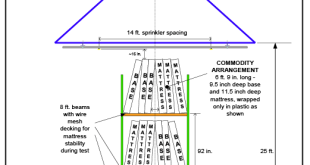The topic for this issue is water supplies for water-based fire protection systems. My entire career has been based on my passion for fire protection hydraulics. In the business, I’m known as a hydraulics nerd. While I deserve that nickname, it still amazes me that many designers, engineers, and Authorities Having Jurisdiction (AHJs) miss the entire point of the hydraulic calculations. This issue’s column shares my thoughts on the topic.
In the case of a sprinkler or standpipe system, we perform hydraulic calculations to determine whether the pipe we install will be of sufficient size to allow the system to perform correctly. Now, I fully understand a lot goes into the hydraulic calculations, such as the amount of water that needs to be delivered per sprinkler or hose, the elevations of all points of the piping system, the pipe material, the pipe inside diameter, the pipe length, the fittings, and the “smoothness” (C-factor) of the inside of the aged piping, among other things. As professionals in this business, we study these variables, make decisions based on the results of the hydraulic calculations, and have others validate whether what we did is based on reality. In the end, the result is a flow and pressure demand we compare to the available water supply to ensure a piping system is properly sized to perform in accordance with the installation standards. The hydraulic calculation method required by NFPA 13 is a good but not perfect engineering approach. The results are reasonably accurate for most typical water-based fire protection systems, and the process is sufficiently uniform to produce results we can all agree on. However, no one should ever assume the results are absolutely perfect in the real world. There are plenty of “assumptions” and rounding allowances to understand every hydraulic calculation has a degree of uncertainty in the result.
Now, before you start to ask what the heck we are doing, let’s understand what we compare the results of the hydraulic calculations to. Every water-based fire protection system requires an adequate water supply. How well do we know the water supply data? When was the data obtained? Who performed the test or model? Were there any adjustments to the raw data to account for daily and seasonal fluctuations, new demands, drought, a “safety” factor, or any other conditions that should be accounted for based on that individual water supply?
The National Fire Protection Association Research Foundation looked at the need to adjust the water supply for water-based fire protection systems. The report concluded that every water supply system used to supply a water-based fire protection system is unique, and the variables need to be evaluated by qualified individuals. For several revision cycles, the NFPA 13 technical committee has considered and debated mandatory adjustments; however, none are required. There is language in the body and annex of NFPA 13 describing what should be considered.
The Society of Fire Protection Engineers position paper number 2020-1 clearly defines who is responsible for this analysis. The analysis is the practice of engineering and design professionals with the proper training, knowledge, and experience needed to perform this work.
In addition, NFPA 13, Standard for the Installation of Sprinkler Systems, 2022 edition has a requirement for an Owner’s Certificate on every project. The purpose of this certificate is to document the basis of the design for the sprinkler system. This includes the water supply information, including any necessary adjustments required. This certificate is to be completed by the owner or his/her designee. On how many projects do you receive this certificate? Unfortunately, I know the answer is not many! This requirement is mandatory for all submissions to the AHJ. This certificate was designed to put the responsibility of the hazard selection, water supply, and seismic classifications, among other things, on the owner since it is their building. As contractors and AHJs, we have little control over how the building will be utilized.
Water flow testing is covered by NFPA 291, Recommended Practice for Water Flow Testing and Marking of Hydrants; however, this document is a recommended practice and not an enforceable standard. Chapter 4 covers water flow testing. NFPA 13 also discusses water flow testing, and since NFPA 13 is a standard, it is enforceable. However, NFPA 13 has no requirements for pressure gauges or testing equipment utilized in water flow testing. Are calibrated pressure gauges required? How often do the pressure gauges need to be calibrated? What accuracy do the pressure gauges need to be? What pressure ranges should the pressure gauges be? Does flow metering equipment need to be listed? Nothing is required by NFPA 13. NFPA 25 currently has requirements for test equipment, including pressure gauges. In my opinion, it is time for NFPA 13 to have similar requirements. The AFSA Technical Advisory Committee will be discussing these items for the 2028 edition of NFPA 13. Until then, it is ultimately the responsibility of the design professional to ensure the water flow test equipment is sufficiently accurate to ensure accurate results of the raw data.
In conclusion, we can produce accurate hydraulic calculations and verify the adjusted water supply data is sufficient for the system. But we spend so much time worrying and verifying every detail of the hydraulic calculations that we might miss the bigger picture. Is the water flow data reliable, current, and adjusted for us to use? We need to ensure the design professional is providing the data. In all cases, make sure the AHJs agree and approve the water supply data utilized. And last but not least, obtain those Owner’s Certificates!
ABOUT THE AUTHOR:

John August Denhardt, P.E., ET, FSFPE, CWBSP, is Vice President of Engineering and Technical Services for AFSA. He is a Professional Engineer (P.E.) registered in the District of Columbia and the states of Delaware, Maryland, Pennsylvania, and Virginia. He is a NICET Level III in Automatic Sprinkler System Layout and Inspection and Testing of Water-Based Systems, and an NFPA Certified Water-Based Systems Professional (CWBSP). He is a member of the NFPA 13 Sprinkler Discharge Committee and is a Fellow of the Society of Fire Protection Engineers (SFPE). Denhardt is a National Fire Protection Association (NFPA) Research Foundation trustee, sits on the University of Maryland Department of Fire Protection Engineering’s Board of Visitors, and is a member of the SFPE Board of Directors. A native of Maryland, Denhardt holds a Bachelor of Science degree in Fire Protection Engineering from the University of Maryland in College Park.
 Sprinkler Age A Publication of the American Fire Sprinkler Association
Sprinkler Age A Publication of the American Fire Sprinkler Association




